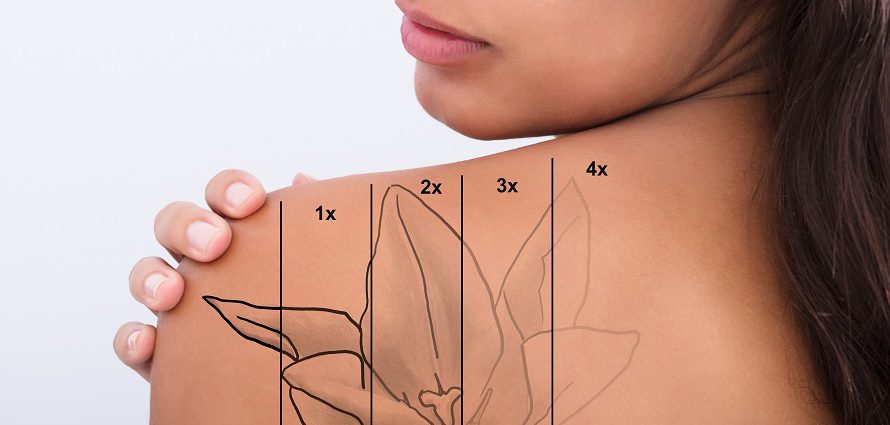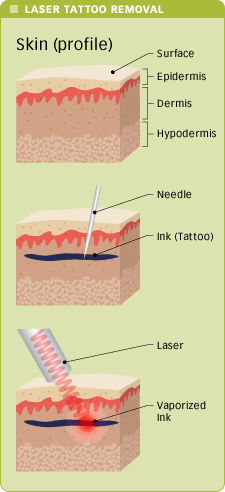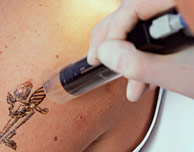Laser Tattoo Removal – Cost, Risks & Side Effects

Getting your boyfriend’s name and likeness tattooed on your shoulder seemed like such a good idea…at the time. But now you have a new boyfriend, a promising career and a bad case of “tat regret.”
You are not alone.
A 2012 Harris Poll found that 21 percent of Americans have at least one tattoo and that 14 percent of them now regret that decision. Data from the American Society for Dermatologic Surgery backs this up. The group reports that the number of tattoo removal procedures increased 52 percent from 2012 to 2013.
Of course, thinking before inking is one solution, but it may be too late for that. The good news is that today’s tattoo removal options are far less barbaric than older techniques. They also work better, faster and require a lot less downtime.
Older methods of tattoo removal include dermabrasion (“sanding” the area) and excision (cutting inked skin out of the area and possibly grafting skin into the area). While these methods may still be used occasionally, lasers are now the standard of care for tattoo removal.
A Brief History of Laser Tattoo Removal
In general, laser tattoo removal works by delivering laser energy to break up ink with short pulses of intense, concentrated light. The wavelengths target only the tattooed pigments, without harming the surrounding skin. Different laser lights are used for different ink colors. Black ink is easiest to remove because it absorbs the full spectrum of light, while green, blue, red, and other colors require more targeted pulses. Your immune system works best in areas of greater blood circulation, which is why ink can be removed faster in those areas. For these reasons, it’s more difficult to remove tattoos on the hands and feet, where there is less circulation.
In the late 1980s and early 1990s, the first sophisticated lasers were introduced to treat tattoos. These included Q-switched or ultrashort-pulse lasers to fragment the individual particles of the tattoo and to decrease their visibility. While these lasers worked (and worked well), greens and blues were still considered especially difficult to remove.
This is where a new picosecond laser comes in. Manufactured by Cynosure, the Picosure delivers a pulse of light that is 100 times faster than older lasers. PicoSure’s short bursts, measured in picoseconds (trillionths of a second), cause the tattoo ink to break apart into tiny particles which are then easily eliminated by the body. Older lasers could turn rocks into pebbles. PicoSure turns pebbles into dust. The new laser also cuts the number of sessions needed to remove tattoos in half, in some cases.

Tattoo removal may require anywhere from one to 10 laser treatment sessions, each treatment lasting only a few minutes (with four- to eight-week intervals between each session). Each treatment penetrates a little deeper, removing more ink and leaving the tattoo progressively lighter.
The Laser Tattoo Removal Procedure
Your dermatologist will examine the tattoo and ink color to determine the best way to remove it. Factors such as the color of the tattoo, your skin tone and texture, as well as your budget will play a role in this decision.
Once a treatment is chosen, your doctor may suggest oral pain medication, such as Tylenol, and a topical anesthetic cream that is applied an hour or two before treatment. In some cases, a local anesthetic is also used.
After the procedure, you’ll receive instructions on how to care for the treated area. This may include anti-bacterial ointment and/or bandaging. You may feel a slight sunburn sensation for a couple of days after the procedure and there may also be some redness for a few weeks.

Side effects of laser tattoo removal are rare, but may include blistering, infection, loss of skin color or scabbing. If scabbing occurs, it usually subsides within two weeks. In most cases, skin returns back to normal. With advances in laser technology and better methods, scarring has become rare.
Cost of Laser Tattoo Removal
Laser tattoo removal cost typically ranges between $250 and $950. If the out-of-pocket cost is too much for you, ask your doctor about payment plan options. For financing options and tips, continue reading about patient financing.
It seemed like such a good idea at the time…
Your tattoo, that is.
A report in the July 2008 issue of Archives of Dermatology found that women are more likely to seek tattoo removal than men and may be motivated by the social stigma associated with tattoos and negative comments made by others.
Researchers at the Texas Tech University Health Sciences Center conducted a survey of 66 men and 130 women who visited one of four dermatology clinics for tattoo removal in 2006. Survey respondents had an average age of 30 and answered 127 questions. Their answers were compared with responses to a similar survey conducted in 1996.
In 2006, participants reported they had gotten a tattoo to feel unique or independent or to make certain life experiences stand out. In contrast, the main reasons for seeking tattoo removal included just deciding to remove it, embarrassment, lowering of body image, getting a new job or career, problems with clothes, being stigmatized or marking an occasion, such as a birthday, marriage or newly found independence.
The 2006 survey also found that participants who had their tattoos removed were more likely to be women who were white, single, college-educated and between the ages of 24 and 39.
While the women were pleased with their tattoos when they got them, their feelings changed over the following one to five years. “While men also reported some of these same tattoo problems leading to removal, there seemed to be more societal fallout for women with tattoos, as the tattoos began to cause embarrassment, negative comments and clothes problems and no longer satisfied the need for uniqueness,” the study authors write.


